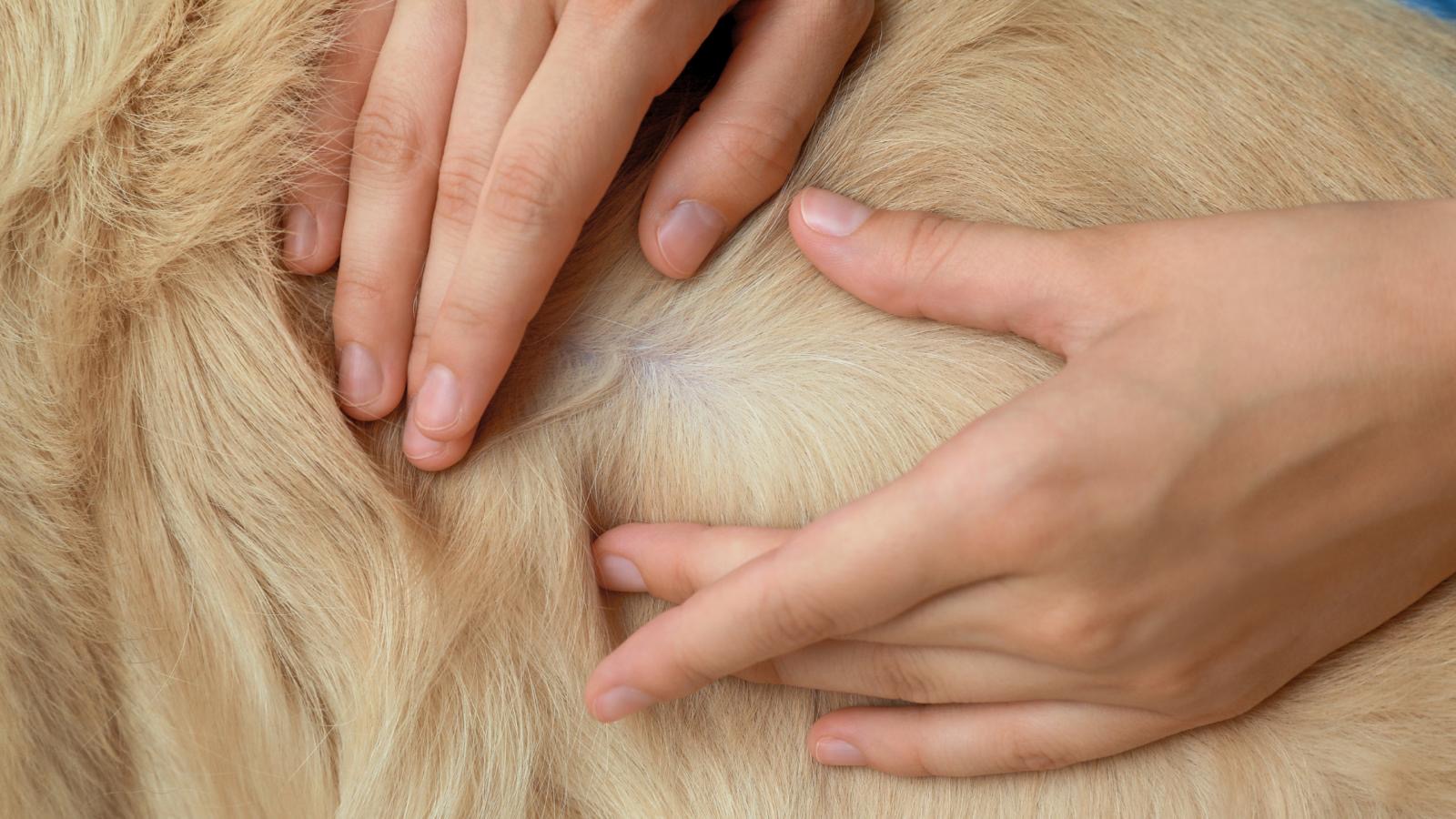The topic for this blog post here at My Pet Nutritionist, is all about the skin, specifically, two skin conditions we see frequently in dogs who come to us for help. Calcinosis Cutis, and Mucinosis are two conditions affecting the epidermis, and can be mild, or severe. Find out more about what they look like, what causes them, and how to support the body in getting rid of them in this blog post.
What Are Calcinosis Cutis and Mucinosis?
Calcinosis cutis and Mucinosis are both skin conditions, which can look quite similar. They both result in hairloss and redness of the skin, usually with either scabs, lesions, or small bobbles of skin, much like a patch of very tiny grapes. The bobbles are more apparent in cases of Mucinosis, and the legions or scabs are more typical of those suffering with calcinosis.
Both conditions are as a result of a build up of substances in the various layers of the skin, but the deposits are different depending on the condition.
Calcinosis cutis occurs when there are deposits of insoluble minerals in the skin, which leads to dystrophic calcification (where blood calcium levels are normal, but calcium salts are deposited in tissues, often due to damage) or metastatic calcification (where blood calcium levels are elevated). Dystrophic calcification is the more common form of calcification found in dogs, but metastatic calcification can happen. This condition is often in one or two smaller patches on your dog, however if the majority of the body is covered in the associated calcium deposits, the vet may diagnose it as
Calcinosis universalis.
Findings Here
Dogs diagnosed with this condition require further investigation, as it occurs as a secondary issue to an underlying, and often severe health problem, which we will go deeper into shortly.
Findings Here
Mucinosis, or Cutaneous Mucinosis, happens when there is a build up of a glycoprotein called Mucin. Mucin is predominantly comprised of Hyaluronic Acid, and is essential in the body and plays a role in immune system modulation, inflammation control, lubrication of the digestive and reproductive tracts, lubrication of joints, and aids in the removal of pathogens, allergens, and foreign bodies. The more Hyaluronic Acid in the body, the more mucin there is, produced by the intestinal epithelium. Excess Mucin in the body is pushed toward the surface of the skin, which leads to severe bobbling and folding of the skin.
Findings Here
Findings Here
A diagnosis of Mucinosis is not usually life-threatening, but secondary issues including breathing issues, eye problems such as entropion, and bacterial skin issues may occur. Mucinosis also occurs as a secondary condition to an underlying health problem, much like those with
Calcinosis cutis.
Causes of Calcinosis Cutis and Mucinosis
Both conditions are as a result of an underlying condition, so let’s take a look at what causes what!
When it comes to breed predisposition, Mucinosis is common in the Shar Pei. This is thought to be due to a genetic mutation which has been inherited from earlier generations, which causes high levels of hyaluronic acid to be present in blood serum. Larger/heavier set breeds, including bulldogs and German Shepherds seem to be affected by
Calcinosis cutis more commonly than other breeds.
Findings Here
Age can be a factor in
Calcinosis cutis too, affecting younger dogs under 2 years of age more commonly than older dogs.
Trauma to the body, and reactions to medications, vaccinations, and foreign bodies can all be common underlying causes of
Calcinosis cutis, as these leave tissues exposed, and vulnerable to inflammation and deposits of calcium mineral salts. Trauma and reactions cause the dystrophic form. Similarly, as inflamed tissues are at higher risk of damage, allergies and intolerances can be linked back to both conditions. Working on allergies, and running an elimination diet is essential for many with these conditions. You can learn more about elimination diets
here. You may also wish to check for allergies using a
nutriscan test.
Findings Here
When we look at specific medications that can cause
Calcinosis cutis, there’s one type we commonly see as a cause of the condition; steroids. The over use of steroids is one of the top contributors to the onset of
Calcinosis cutis in its metastatic form. Long term steroids can leave the body open to so many diseases, which is why it’s always best to get to the root cause of your pet’s issue, and only use steroids short term, and as a last resort.
Findings Here
Much like the over use of steroids, the over production of corticosteroids, which are adrenal hormones used by the body in the control of inflammation, is another of the most common underlying problems associated with
Calcinosis cutis. The condition ‘hyperadrenocorticism’ (commonly known as Cushing’s Disease) is where the adrenal gland over produces corticosteroids as a result of adrenal cancer, pituitary cancer, or overgrowth of the adrenal glands. Unfortunately, the presence of too much corticosteroid in the body can supress the immune system, and damage the gut microbiome, which causes deposits of calcium to build up in the skin.
Findings Here
Kidney disease can also be an underlying cause of a build up of calcium in the skin, as their main role is to remove waste and excess products from the blood. If the kidney is unable to function properly, it wont be able to filter out any excess mineral salts. This is more common in cats than dogs, but can also happen in dogs in rarer cases. In dogs, kidney disease and the associated onset of
Calcinosis cutis can be caused by contraction of leptospirosis.
Findings Here
Those with cancerous tumours on major glands in the body can also cause the blood calcium concentration to raise, leaving the body with excess calcium to be pushed through the layers of the skin, causing
Calcinosis cutis.
Findings Here
When it comes to non-genetic underlying causes of Mucinosis in dogs, there are two theories, both regarding hyaluronic acid. The first is that there is a defect in the metabolism of hyaluronic acid in the body. Being less able to metabolise it, means there will be an abundance of hyaluronic acid, causing deposits of it to be pushed to the surface of the skin. the other theory suggests that the body produces too much hyaluronic acid, which means the normal functioning organs and glands are unable to cope with the sheer amount, causing it to be pushed to the skin’s surface as mucinosis. The challenges with hyaluronic acid can be linked to hypothyroidism too, which is an underactive thyroid.
Findings Here
Findings Here
Diagnosis and Conventional Treatment
When your veterinarian takes a look at the condition of your dog’s skin, and takes into consideration the dog’s age, breed and medical history, it is likely they already have a good idea of which condition the dog is suffering with. This will then be confirmed through a skin scrape or skin lesion biopsy, where a sample of the affected area is taken, and analysed in the laboratory under a microscope. A veterinary pathologist would be the specialist to deal with this analysis. Blood samples will also be analysed in order to see any excessive levels of calcium, mucins, or hyaluronic acid.
If mucinosis is suspected, the skin sample will be analysed using a special stain which helps to detect excess mucins in the layers of the skin.
As well as sampling for the aforementioned mineral salts and hyaluronic acid, the veterinarian will be able to detect any underlying endocrine diseases like hyperadrenocorticism, hypothyroidism or kidney disease.
When it comes to treatments your veterinarian may offer, it very much depends on the underlying condition causing it the skin condition. The treatment for each individual therefore, will be completely unique. To help you understand the possible treatment paths for each underlying condition, you can read more in the following blogs:
Everything You Need to Know About Cushing’s Disease (Hypoadrenocorticism)
Ultimate Guide: Hyperthyroidism
Kidney Disease and Natural Nutrition for Your Pet
In particularly severe cases of Mucinosis, corticosteroids may be prescribed as a short term measure to reduce the mucins in the skin, which may cause loss of flesh in the dog’s muzzle, and may be a permanent change in your dog’s appearance. Due to the risk of
Calcinosis cutis in dogs on steroids, this avenue is avoided as much as possible and is only used if absolutely necessary.
Supporting the Body Naturally
As with most conditions, there are some things we can do naturally, to help support the body. As with the conventional treatments, support will differ depending on the underlying cause of the
Calcinosis cutis or Mucinosis.
The supplements which are most important for both conditions, regardless of underlying cause, are gut health supplements, as gut health is essential for immune function, which in turn can benefit the endocrine system. Mucilage herbs to heal and soothe the gut such as slippery elm, marshmallow root and deglycyrrhizinated liquorice are a great addition. Probiotics are also essential for keeping a healthy microbiome as the gut flora will flourish. A healthy gut microbiome contributes to a healthy skin microbiome.
Our supplement,
Gut Guardian may be perfect for your dog!
Zinc is an important nutrient for both a robust immune system, and a healthy epidermal matrix, so ensuring plenty of zinc-rich foods are included in your dog’s diet is essential. You can learn more about zinc
here.
In order to reduce inflammation, and keep it at bay, omega 3 fatty acids are incredibly important. Omega 3 is anti-inflammatory, which helps combat the inflammation caused by various conditions, and also by the consumption of omega 6 fatty acids which are inflammatory, and are found in abundance in our dog’s meat rich diet. You can learn about feeding fatty acids
here.
It is also very important to remove all environmental toxins, due to the risk of reactions which lead to
Calcinosis cutis and Mucinosis. This includes all flea and worm products, vaccinations, and household cleaning products. Removing these removes stress on the body, and leaves it less vulnerable to tissue damage and in turn, less vulnerable to these skin conditions.
When looking at foods for your dog, of course we recommend a fresh food diet, and incase of intolerances, you may be best feeding a fresh cooked diet, using a novel protein, such as the recipes below:
Topically, there are lots of skin nourishing products owners may wish to use to try to keep skin supple, particularly around the affected areas where a dog may be itching. Keeping surrounding areas soothed and itch free helps to reduce the risk of trauma to the tissues, which reduces the risk of mineral salt deposits in areas of trauma, and therefore stops the ‘spreading’ of the
Calcinosis cutis or Mucinosis.
We hope this blog post goes a long way in helping you overcome your dog’s Calcinosis Cutis or Mucinosis, and has given you a greater understanding of the conditions to help you prevent them from returning. If you require extra help with this complex condition, please don’t hesitate to book a consultation with one of our team!
Team MPN x 







